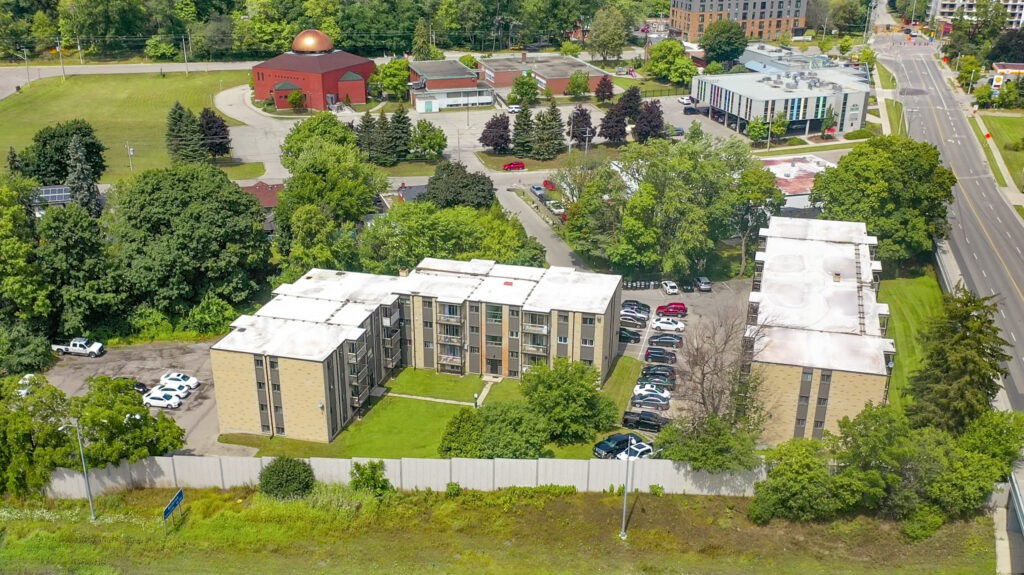Raising finance can be challenging for many groups looking to set up co-operatives, particularly those in sectors like housing.
This serious barrier still causes problems in countries with sizeable housing co-op sectors, like Canada. It has over 6,300 co-operatives overall, contributing CA$49.2bn (2.5%) towards the country’s GDP. Around 59% of these co-ops are non-profit, and 52% are housing co-ops.
“We know that banks are not going to provide us a 100% mortgage – we need to have equity in there somewhere,” says Sean Campbell, executive director of Union Sustainable Development Co-op (Union Co-op).
“Government grants are not sufficient for us to grow at the scale that our communities need. So we need a different source of capital. For us, that means reaching out to our community – folks who care about affordability and co-operative and community ownership.”
Based in Waterloo, Union Co-op has a mandate that all of its investors need to be members and be local to their community.
“Different models and different contexts will suggest that one may be a better fit than others,” says Campbell. “For us here, we know that banks like to see equity when they’re providing a loan, and shares can show up in your balance sheet as equity.
“It means that in one year, if we don’t have enough money to pay a return or we only have enough money to pay a smaller return, we can do that. We can make that decision as an organisation and then, in another year, we can increase it.
“So that reduces pressure on housing properties and on our tenants, compared to a bond with fixed rates of interest that can be a little more challenging.
While most of Canada’s housing co-ops date back to the 1970s and ’80s, the co-op model is becoming popular again due the country’s housing affordability crisis.
Campbell argues that a nonprofit or co-op is less likely to be pushed into default by their community. “When we compare the returns that nonprofits and co-ops are providing to their community investors are typically similar to or even below your cost with less strict terms and less default risk at the same point,” he says, adding that this also helps keep money locally within the community.
Investing in community share offers is, he adds, “an important act of solidarity and relationship building”.
“It creates a powerful long-term connection from the community to the underlying organisation,” he says. “We have hundreds of community members who themselves do not live in affordable housing but care about it and now can use their voice in a different way in solidarity with the folks that do.”
The model means that communities have one more tool at their disposal, says Campbell, which they can deploy “alongside the great work of existing nonprofits, charities and municipal governments”.
It offers a powerful potential, he says, “to provide housing for folks in need and offer one more option for the co-operative sector to live out its principles of ensuring that there’s economic participation – in this case it just happens in a different format.
“It means that we are able to be autonomous by not being completely reliant on non-member or government sources of capital. And whatever the politicians of the day may say, this is a way that we get to come out to our community, and to our members, and say, ‘let’s go, let’s do this ourselves – and other folks can come along if they fit with what we need’.”

The success of other co-ops in Canada and the US served as an inspiration to the group behind Union Co-op.
“We were we were inspired by other people using the co-op model,” says Campbell, pointing to co-ops in Alberta, Nova Scotia, and British Columbia. Housing co-ops are being set up in the US as well, with the East Bay Permanent Real Estate Co-operative (EB Prec) working to create permanently affordable, community-controlled homes for disenfranchised groups.
“It’s a black-led organisation to push back against displacement, rising rents and ensure control and access,” he said of EB Prec. “We see the movement playing with the co-op model in different ways and we thought this could be a great way of bringing this back to Ontario.”
Co-ops in other sectors are being set up in Ontario, from energy to industry, which also helped provide real-life examples.
“The co-op model gave us a little more flexibility to make sure that we were able to engage the general public and not just wealthier folks, in making community-level investments,” says Campbell.
“We were able to do shares as well as bonds rather than just being restricted to bonds and we like the long-term and ongoing engagement that comes with being a member as opposed to just being a bond investor. All of those pieces, taken together, meant that we were walking in the shoes of all of these really inspiring organisations – both locally in the housing sector and renewable energy, and also more broadly in these model aspects made it the right approach.”
Union Co-op plans to start raising funds again this year in order to purchase more buildings.
“We’re continuing to focus on residential properties at the moment,” adds Campbell, “to help with the housing crisis and to support more folks. But we also know that the organisations and small businesses which make our community a great spot also need affordable homes, and we’ll look down the road for opportunities to acquire buildings with commercial units in there as well.”

One organisation helping non-profits and co-operatives in raising community financing to make their projects a reality is s Tapestry Community Capital. With Tapestry’s support, groups can launch community bonds and secure the funding they need.
“Community bonds are essentially a loan that a community member can give to a nonprofit charity or co-op that’s raising money for the project,” says co-executive director Ryan Collins-Swartz. “They are an alternative to a donation or a grant as a way that puts the organisation that needs to raise money in control of its financing – so it can raise the money when it wants it, and gets to also set the terms of the financing and engage community members directly as investors in their work.”
Tapestry was launched by Toronto Renewable Energy Co-operatives (Trec), a co-op promoting community-owned renewable energy solutions, which Collins-Swartz joined over six years ago and still serves as a co-executive director.
Trec set up Tapestry to support co-ops in other sectors while building on its experience in helping groups raise community investments to launch renewable energy co-ops.
“This model of raising funds could be used by all types of co-ops but was only really being used in renewable energy,” says Collins-Swartz. “The mission of Tapestry is to expand this work, to make it possible for all different types of co-ops to raise investment – and also think about the support that is needed at every stage for it to be possible.
Related: Impact of community shares model increasing across the UK
“We act as a bridge between organisations that need to raise capital and local investors who want to place their investments into positive things. So we act as a guide every step of the way to educate, get the community investments set up raising the funds and also doing the management of the investors.”
Tapestry works with a range of organisations with a social purpose. Active in various sectors, from housing to social services, they include charitable organisations, social enterprises and co-ops. In total, Tapestry has supported over 600 co-op projects, including some by Solar Share, Canada’s largest renewable energy co-op.
“They’ve raised over $80m in community bonds that had a $1,000 minimum investment,” says Collins-Swartz. “It’s a pretty incredible story of how they have thousands of investors, all pooling their money together.”

Another sector Tapestry has supported is housing. Examples include Propolis housing co-op in British Columbia, which is raising $1.1m through community bonds to launch a 50-unit net zero co-operative housing development.
Investment in community bonds is open to everyone in Canada, says Collins-Swartz. “It’s a very democratic way of raising investment which aligns with the democratic principle of co-ops.
“The minimum investment can be very low, you don’t have to be an accredited or high net worth investor. It can be a local community member investing $500. But we also see foundations, businesses, and institutions, sometimes investing several $100,000 in the same project. So it casts a really wide net for the organisation to involve their community.”
Tapestry tends to focus on supporting groups looking to develop big capital projects. This is also thanks to Ontario not enjoying the same level of support as provinces like Quebec, where more government funding is available to co-ops.
Related: Boost for housing co-ops as Chrystia Freeland tables Canada’s federal budget
When a co-op wants to raise capital, it has to put together an offering document that needs to be reviewed and approved by the Financial Services Regulatory Authority of Ontario. “It’s actually a pretty good system, whereas for some of the nonprofits that we work with there is no oversight body,” says Collins-Swartz.
He thinks the groups could be further encouraged to invest in community bonds through tax incentives. Another way to support such initiatives would be to put in place more regulatory support.
“We don’t help with setting up a co-op,” adds Collins-Swartz. “We help more when they’re ready to raise capital and we’ll help them raise investment.”
Tapestry is funded through a mix of grants, government funding and client fees and provides support with setting up community bond campaigns, raising funds and managing investors. The actual fundraising can take up to six months, but first organisations must spend one or two months on feasibility studies.
“We guide them through all that feasibility and learning and then it takes about another couple months to set up their bond campaign where we put together the investor documents and marketing plan, get them set up on the system,,” says Collins-Swartz.
“We keep trying to see how we can make it faster – and it is still much quicker, compared to waiting for a grant or even working with a bank or leading a donation campaign.”
In fact, investors can get their bonds in less than a month. “A lot of our investors, they’re essentially community supporters of the co-op or nonprofit,” says Kyle Zhang, Tapestry’s vice-president of finance.
Some of the organisations Tapestry supports already have a bond campaign on their website, where investors can click to find out more about the terms of the bond and the interest offered. Once on the investor portal, they can fill in the information required, which includes their social insurance number, address information, and banking details, and then select the bond investment that they wish to support.
“Once you submit that application, it comes through our backend,,” adds Zhang. “We review the application, make sure that everything is complete, and then we’ll approve your application to which you’ll get a notification and then we’ll process the funds.
“So essentially, we will draw funds from your bank account into the client’s bank account, and then we’ll issue the bonds. So to become an investor and get your application approved, I would say can take less than a week to process those and get everything going.”
Some investors automatically become members of the co-ops, while others stay as investors. This depends on the individual co-op.
Going forward, Tapestry plans to focus on growth across Canada. “We want to support a greater diversity of types of projects,” says Collins-Swartz. The organisation also plans to increase participation from retail and individual investors, using technology to make the investment process more simple.
Other priorities include raising awareness of community bonds and building more partnerships with banks and other institutions, including pension funds, foundations and investment funds to bring more capital in and make it easier for organisations to raise money.

